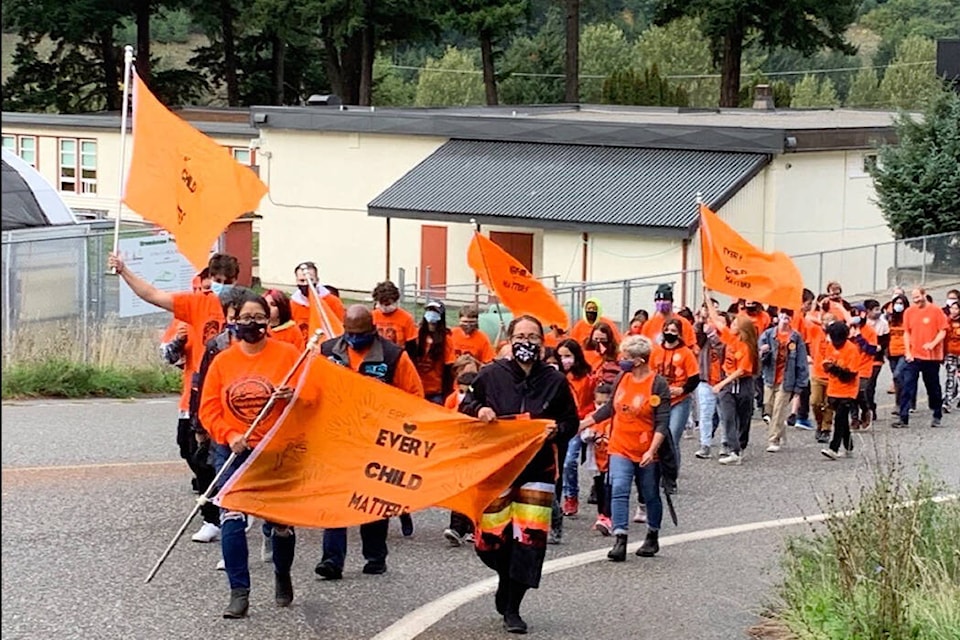Editor’s note: The story below may trigger difficult or traumatic thoughts and memories. The Indian Residential School Survivors Society’s 24-hour crisis line is available at 1-866-925-4419.
Though the inaugural National Day for Truth and Reconciliation meant a day off of school, students, teachers and staff throughout the district participated in remembrance-oriented events leading up to Sept. 30.
Superintendent Balan Moorthy said the school district hosted a number of age-appropriate events leading up to this year’s inaugural holiday. For example, kindergarteners would have read or watched videos of several relevant books, such as “Phyllis’s Orange Shirt,” “Sometimes I Feel Like a Fox” and “Shi Shi-Etko.” Some upper grades also held class discussions, made orange shirts and Every Child Matters buttons.
Moorthy said the National Day for Truth and Reconciliation was particularly important for the school district due to the fact that 40 per cent of the district’s student population are Indigenous.
RELATED: School District 78 appoints new District Principal of Indigenous Education
“I think as a district and a country, we’re starting to get it a lot more,” Moorthy said. “Orange Shirt Day will eventually have the significance that Remembrance Day had in Canada as a pivotal day to recognize the history and atrocities that occurred for indigenous peoples, how residential schools worked and how a lot of the cultural genocide really started.”
Christine Seymour is a proud member of the Stó:lo First Nation and the new district principal of Indigenous education. She walked with students from Boston Bar Elementary to the old aerial cable ferry site heading to North Bend, where she spoke and sang as students placed flags in remembrance of residential school victims, including members of her own family.
“This year, it’s different,” Seymour said. “I think before the 215 was revealed, I felt like we were working to validate the history. After 215, it was like we didn’t have to work so hard to share. There was a sense of relief.”
When she goes about her work making Indigenous voices heard in local education, Seymour’s mind often turns to the damage the residential school system has done.
“I think communities are waking up to that truth, and I think so are Indigenous people,” Seymour said. “We’ve grown up with the stories; However, I think that our people are realizing the effects that we’ve been walking with, the effects of residential school, and we’re realizing where we are in relation to it.”
Language plays a crucial role in Indigenous cultures; Seymour, a former Halq’emeylem instructor in the Chilliwack School District, said there used to be approximately 60 different Indigenous languages in Canada. She said students in residential schools were severely punished for speaking their language and as a result, many became afraid of their cultures.
“My dad’s generation start building our long houses again,” she recalled. “he told us about how they would have to sleep in long houses because some of the people would try to burn them down because they were so afraid of the culture because of the residential school system had instilled that in them.”
During her studies, Seymour always remembered an analogy from Dr. Linda Tuhiwai Smith of broken eggshells versus a puzzle to illustrate Indigenous cultural healing after colonization.
RELATED: B.C. marks 1st National Day for Truth and Reconciliation
“If we were going to take a puzzle, we could kind of strategize and take like the pieces with the edges. We could take the pieces, and group them if they’re all from the same color or from the same object on the puzzle, and we could put the puzzle back together,” Seymour said. “But when you have broken egg shells, where do you begin? There’s no edges to work from, or no color to work from. I think that’s the place I’m working from is that egg shell picture.”
Seymour wrestled with finding her identity as an Indigenous girl when she was a child. Much of Seymour’s current knowledge of her roots and culture comes from her education, tape recordings and notes her grandfather took in an effort to preserve the language.
“I found my grandfather’s notes from a class that he took trying to learn how to teach the language during the time he should have been retired,” she recalled. “But he was working to revitalize and save the language.”
Even as education continues to evolve toward more inclusive curriculum, Moorthy said younger people are already playing a crucial role in battling multiple issues of inequality across Canada.
“It’s really the younger population that’s leading the way,” Moorthy said. “When I think about what happened with Black Lives Matter and I think about who the major initiators of it are, there was far more power in that crowd that was under 35 than the ones that are over 35 – partly because of a generational difference; partly because the population that’s under 35 is more justice-oriented. They really have a different lens on the world and what it means to have an equitable society.”
Seymour hopes her work and that of the Indigenous education staff throughout the district helps students reclaim their cultures. The process of her own education has been healing for her.
“Sometimes, it makes me sad that I have to do it from a book and not our elders, our traditional way of teaching us through oral history,” she said. “But I have to really work hard to ground myself and to think about future generations, so that I continue and be strong and do the work I need to do so maybe our next generation will have their elder with them, teaching them.”
“The fact of the matter is our culture and our people are healing from over 100 years of residential schools,” Seymour said. “It’s education that got us here, and it’s education that’s going to get us out.”
@adamEditor18
adam.louis@ ahobserver.com
Like us on Facebook and follow us on Twitter.
